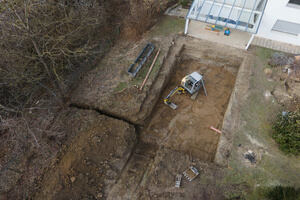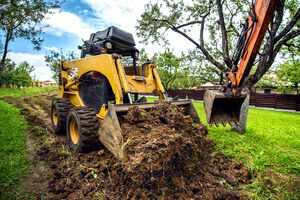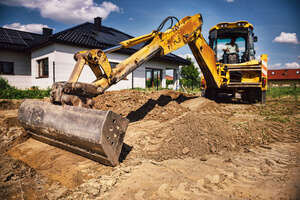The decision to have a swimming pool installed marks the beginning of a very exciting journey to greater enjoyment of your yard and plenty of fun for your family and guests. However, swimming pool installation is a complicated process that must be carried out by professionals to ensure that your pool is safe and stands the test of time. The first step on the path to pool ownership is pool excavation.
The excavation process is one of the most complicated steps in a pool installation and tends to be very messy and noisy. Here is a look at what you need to know about the pool excavation process in 2023.
The Soil Must Be Tested First

Before a pool contractor begins building an inground pool, they will typically perform a soil test to see what type of soil they will be working with. Clay, gravel, sand and organic matter can all impact the approach they take to digging up the yard. These tests will also ensure that the area is suitable for the installation of an inground pool.
Underground Utilities Should Be Marked
Before an inground pool is dug, it is important to call the national Call Before You Dig line at 811. They will call a county official out to your property to mark underground utilities, using different colors of paint to denote lines for cable, water, electricity and gas.
Contractors Will Lay Out the Pool Shape Before Beginning
One of the earliest steps in the pool excavation process is physically laying out the shape of the pool in the ground of the backyard. Homeowners can choose from a range of pool shapes depending on their aesthetic preferences and the pool’s intended use.
- Rectangular Pools: These are one of the most popular shapes for pools. In addition to being aesthetically pleasing, they are also highly practical as their long, straight lines allow those who are using their pool for fitness to swim laps.
- Oval Pools: Another popular shape for swimming pools in 2023 is the oval. An oval-shaped pool can provide a significant amount of swimming space and is a better choice for those who prefer the look of rounded lines to straight edges.
- Multi-sided Pools: Depending on the size of the pool and other design considerations, some pools may have multiple sides, such as hexagons or decagons.
Other popular shapes include kidney-shaped pools, Roman-shaped pools, L shapes, and freeform designs.
The shape must be chosen prior to the excavation getting underway. Your pool contractors will stake the shape out and paint it on the ground, allowing you to see the actual space that the pool will occupy. This provides you with one last opportunity to make any changes to the design that might be needed. Make sure you are happy with the layout before the excavation begins.
Digging Is a Significant Undertaking

Next, it is time for the excavation to get underway. Your pool contractors will dig the shape and depth of the pool, and you will start to see the design come together as more dirt is removed and the pool floor begins to take shape. This can be a very exciting moment as you realize how close your pool dreams are to becoming a reality.
The Amount of Dirt Removed Can Be Staggering
Many homeowners are surprised when they see just how much dirt is removed during the excavation process. Visually, it can look like much more than the space it occupied would hold; some contractors say that picturing the amount of dirt you expect to be excavated and multiplying it by five will give you a more accurate picture of just how much dirt will need to be hauled away from the site.
A professional pool contractor will take care of removing the dirt, but it is important to clarify this beforehand so you are not stuck scrambling to figure out what to do with a huge pile of dirt that occupies significant space in your yard. In some cases, however, some soil may be intentionally left behind to be used for backfilling the hole, leveling the yard or preparing the area for the installation of a deck.
Unexpected Obstacles May Arise
Although your excavator or pool contractor will do their best to ensure it is safe to dig before the work gets underway, there is always a possibility of encountering an unexpected roadblock. Some problems simply cannot be seen or anticipated, such as the presence of unusually large rocks or soil instability, and these can prolong the digging period. However, it typically takes no more than a day to dig the hole for a residential pool, unless you choose a very complicated pool layout or the pool is especially large.
Your Yard Will Be in a State of Upheaval

As you might expect, your yard will be in a state of upheaval during the excavation for your pool. This task requires the use of heavy machinery such as excavators, backhoes and dump trucks, so you can expect lots of traffic in and out of your yard. Depending on the location of the site in your yard where the pool will be built, you may even need to temporarily remove some fencing so the excavation team can access the area with their equipment. Your contractor should let you know in advance if this will be necessary; an opening of around eight feet is enough to get machines into most yards for pool excavation.
You should plan to keep children and pets indoors while this work is being carried out to avoid the potential for accidents. It is also important to avoid walking in the area; the edges of the hole are often vulnerable to crumbling. It is a good idea to let your neighbors know in advance when noisy work will be carried out to avoid conflicts.
Contact the Northern Virginia Excavation and Site Work Professionals
If you would like to learn more about pool excavation, reach out to the experienced professionals at Dirt Connections to discuss your project.
Summary

Dirt Connections was started with one goal in mind: providing quality residential and commercial construction services to clients on time and on budget. Reach out for more information on how we can support your next project.
For your convenience our estimates are free and by appointment. Call 703-940-9949 for a free estimate today!










































